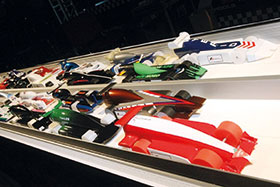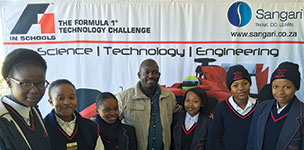

Sangari South Africa, a provider of learning solutions, has launched the ‘F1 in Schools Technology Challenge’ 2016 race season in its search for a team to represent South Africa at the World Finals in 2017. The aim is for learners between the ages of 11 and 19 to design, manufacture and race their own miniature Formula One cars.
The F1 in Schools Technology Challenge has become well-known worldwide as an educational competition that actively promotes Science, Technology, Engineering and Mathematics (STEM). There are over 44 countries participating, making it a prestigious and fun event where the value of learning is showing exceptional results.
Pieter du Plessis, F1 in Schools programme manager at Sangari, said teams of three to six students are formed, a team name selected and students assigned their roles. Teams wanting to participate in the regional competition register their team and seek sponsorship to compete. The process follows the same process as a real Formula One team.
“The programme develops a true entrepreneurial spirit in students. They are required to prepare a business plan, do research and build links with industry to gain sponsorship. Students gain first-hand experience in marketing and accounting, needing to provide a complete portfolio as part of the competition,” he said.
“Registration for the programme is free for all schools in South Africa,” said Bez Sangari, MD of Sangari South Africa. “The F1 competition focuses on blended learning through a cross curricula approach where learners physically apply what is learnt in the classroom. The true value lies in how learners take ownership of their own learning.
“What makes the F1 in Schools Technology Challenge different is that it entails a comprehensive and inclusive learning approach. Learners engage with subjects that improve their literacy, numeracy, sport and sports science, design and technology, art and design, textiles knowledge, STEM learning, computing, and business and enterprise.”

The programme focuses on using ELT (experiential learning theory) as an approach where learners go through the physical experiences themselves. In their teams they are faced with challenges, victories, planning and obstacles that need to be overcome to succeed. This teaches teamwork and develops communication along with leadership skills from a young age.
Using 3D CAD software, they design a car based on the specifications set by the international rules committee and use computational fluid dynamics (CFD) software to analyse their car designs. Using 3D CAM software, the teams evaluate the most efficient machining strategy to make their cars.
Schools gain the benefit of the blended learning process, and teams that are set on competing are encouraged to obtain sponsorship. Opportunities exist for sponsors to display their logos on team cars at events, while primary sponsors will have exposure on the F1 in Schools website and at race events.
The teams wishing to enter the official competitions on regional, provincial, national or international level would have to source sponsorships as these have different entry costs. Teams would also need to source sponsorship for manufacturing cars which vary from the manufacturing centre they use.
Other costs that teams need to consider are the branding of team uniforms, creating and printing pit displays, printing portfolios, travel and accommodation. The teams do this by providing sponsor branding exposure on their pit displays, portfolios, team uniforms, presentations and racing cars. Sponsors are often companies in close proximity to the school and the added benefit is that graduates from the school are absorbed into the organisation, thereby ensuring a viable return on their investment.
For more information contact Pieter Du Plessis, +27 (0)11 466 1440, [email protected], http://sangarisa.co.za/f1-in-schools

© Technews Publishing (Pty) Ltd | All Rights Reserved